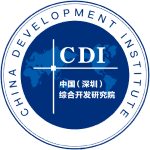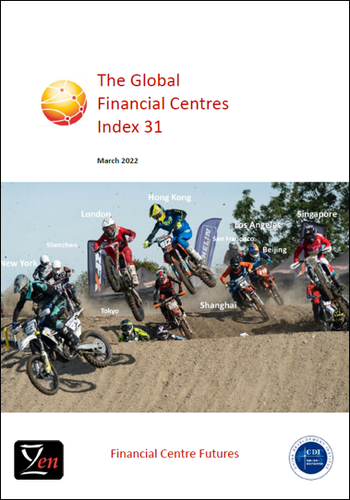Authors
Mike Wardle, Professor Michael Mainelli
Published by
Long Finance & Financial Centre Futures (March 2022), 63 pages. Produced by Z/Yen in Partnership with CDI.
Share on social media:


You might also be interested in:
The Global Financial Centres Index 31
The thirty-first edition of the Global Financial Centres Index (GFCI 31) was published on 24 March 2022. GFCI 31 provides evaluations of future competitiveness and rankings for 119 financial centres around the world. The GFCI serves as a valuable reference for policy and investment decision-makers.
China Development Institute (CDI) in Shenzhen and Z/Yen Partners in London collaborate in producing the GFCI. The GFCI is updated and published every March and September, and receives considerable attention from the global financial community.
126 financial centres were researched for GFCI 31 of which 119 are now in the main index. The GFCI is compiled using 150 instrumental factors. These quantitative measures are provided by third parties including the World Bank, the Economist Intelligence Unit, the OECD and the United Nations.
The instrumental factors are combined with financial centre assessments provided by respondents to the GFCI online questionnaire. GFCI 31 uses 74,982 assessments from 11,934 respondents.
GFCI 31 Results
Overview
Among the top 40 centres, only one centre rose more than 10 rank places and none fell more than 10 places. Overall the average rating was stable, less than one point lower than GFCI 30, following three consecutive drops in the average rating.
Asia/Pacific centres generally recovered losses that they experienced in GFCI 30. This suggests that there is restored confidence in the economic strength of the region, and in trade performance. North American and Western European centres had generally stable performance.
The data on which GFCI 31 is based relate to the period up to the end of 2021. While we might have expected more volatility in the ratings as the world continues to recover from the Covid-19 pandemic, the broadly level ratings in the index suggest that in the last half of 2021, confidence was returning to the world economy.
However, the invasion of Ukraine by the Russian Federation will affect future ratings in ways that we cannot predict, except that it seems clear that the performance of the Russian financial centres in Moscow and St Petersburg is likely to fall sharply following the imposition of broad international sanctions against the Russian economy.
Leading Centres
- New York leads the index, with London second, ahead of Hong Kong and Shanghai.
- Shenzhen returned to the top ten in the index, replacing Paris, which fell to 11th place.
- The ratings of most of the leading centres were relatively stable, only changing by a few points.
Western Europe
- London continues to lead in the region, but dropped 14 points in the ratings, the biggest drop in the ratings among the top 20 centres.
- Other leading Western European centres were generally stable, although Berlin and Glasgow improved more than 10 rank places, while Hamburg, Stuttgart, Jersey, and Liechtenstein fell 10 or more ranking places.
- Lugano joined the index for the first time, entering in 72nd position.
Asia/Pacific
- Following relatively poor performance in GFCI 30, two thirds of the Asia/Pacific centres in the index either matched or improved their ranking in GFCI 31.
- Hong Kong continues to lead the region in third position globally, with Shanghai moving up two rank places to fourth and Singapore dropping two places to sixth position
- Ho Chi Minh City joins the index for the first time at 102nd position.
North America
- North American centres fell back after a strong performance in GFCI 30, with seven of the 12 centres in the region falling in the rankings.
- Six North American centres now feature in the top 20.
- Atlanta joins the index for the first time, entering in 63rd place.
Eastern Europe & Central Asia
- Moscow, Warsaw, and Istanbul lead in the region, and in contrast to GFCI 30, the majority of centres fell in the rankings in GFCI 31.
- As indicated above, we expect the position of Russian centres to fall sharply in future editions of the index, as international sanctions in response to the invasion of Ukraine have an impact on their performance.
Middle East & Africa
- Dubai and Abu Dhabi take first and second places in the region, both improving in the ranking slightly, as they did in GFCI 30.
- Casablanca continues to be the leading African centre, while Cape Town and Johannesburg continue to improve their ranking to challenge for the leading African position.
- The majority of centres in the region fell in the rankings.
Latin America & The Caribbean
- Mexico City leads in the region, with Rio de Janeiro remaining in second place. Sao Paulo, Cayman Islands, Santiago, Bogota, and Bahamas improved their position in the index.
- Other centres fell back, and Buenos Aires, Barbados, and Panama fell over ten places in the rankings.
FinTech
- We are able to assess 113 centres for their Fintech offering. New York and Shanghai retain their leading positions at first and second place. Beijing and San Francisco overtook London to take third and fourth place.
- German, Indian, and Chinese, and South African centres performed well in the FinTech ratings, with significant improvements in the ranking for Munich and Berlin, Mumbai and New Delhi, Chengdu, Hangzhou, and Dalian, and Cape Town and Johannesburg.




